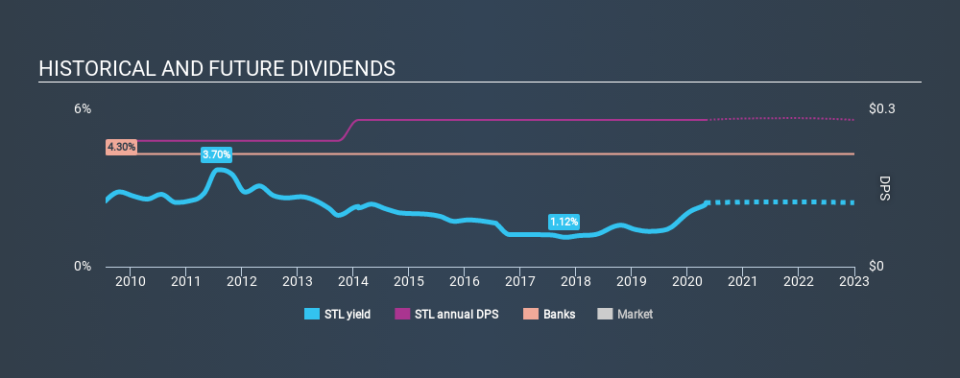Sterling Bancorp (NYSE:STL) Looks Like A Good Stock, And It's Going Ex-Dividend Soon

Some investors rely on dividends for growing their wealth, and if you're one of those dividend sleuths, you might be intrigued to know that Sterling Bancorp (NYSE:STL) is about to go ex-dividend in just 3 days. This means that investors who purchase shares on or after the 7th of May will not receive the dividend, which will be paid on the 22nd of May.
Sterling Bancorp's next dividend payment will be US$0.07 per share. Last year, in total, the company distributed US$0.28 to shareholders. Based on the last year's worth of payments, Sterling Bancorp stock has a trailing yield of around 2.4% on the current share price of $11.47. Dividends are an important source of income to many shareholders, but the health of the business is crucial to maintaining those dividends. We need to see whether the dividend is covered by earnings and if it's growing.
View our latest analysis for Sterling Bancorp
Dividends are usually paid out of company profits, so if a company pays out more than it earned then its dividend is usually at greater risk of being cut. Sterling Bancorp paid out just 17% of its profit last year, which we think is conservatively low and leaves plenty of margin for unexpected circumstances.
Generally speaking, the lower a company's payout ratios, the more resilient its dividend usually is.
Click here to see the company's payout ratio, plus analyst estimates of its future dividends.
Have Earnings And Dividends Been Growing?
Companies with consistently growing earnings per share generally make the best dividend stocks, as they usually find it easier to grow dividends per share. If earnings decline and the company is forced to cut its dividend, investors could watch the value of their investment go up in smoke. For this reason, we're glad to see Sterling Bancorp's earnings per share have risen 18% per annum over the last five years.
Many investors will assess a company's dividend performance by evaluating how much the dividend payments have changed over time. In the past ten years, Sterling Bancorp has increased its dividend at approximately 1.6% a year on average. Earnings per share have been growing much quicker than dividends, potentially because Sterling Bancorp is keeping back more of its profits to grow the business.
The Bottom Line
From a dividend perspective, should investors buy or avoid Sterling Bancorp? Typically, companies that are growing rapidly and paying out a low fraction of earnings are keeping the profits for reinvestment in the business. Perhaps even more importantly - this can sometimes signal management is focused on the long term future of the business. Overall, Sterling Bancorp looks like a promising dividend stock in this analysis, and we think it would be worth investigating further.
While it's tempting to invest in Sterling Bancorp for the dividends alone, you should always be mindful of the risks involved. For example, we've found 2 warning signs for Sterling Bancorp that we recommend you consider before investing in the business.
If you're in the market for dividend stocks, we recommend checking our list of top dividend stocks with a greater than 2% yield and an upcoming dividend.
If you spot an error that warrants correction, please contact the editor at editorial-team@simplywallst.com. This article by Simply Wall St is general in nature. It does not constitute a recommendation to buy or sell any stock, and does not take account of your objectives, or your financial situation. Simply Wall St has no position in the stocks mentioned.
We aim to bring you long-term focused research analysis driven by fundamental data. Note that our analysis may not factor in the latest price-sensitive company announcements or qualitative material. Thank you for reading.

 Yahoo Finance
Yahoo Finance 
